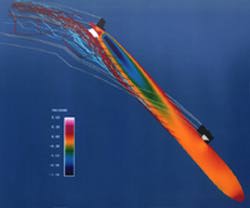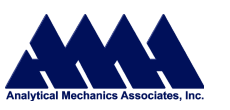Prediction of Vortex-Induced Hydrodynamics of Maneuvering Submersible Vehicles
The mission requirements of underwater vehicles often involve rapid maneuvers at high speeds where the submersible can encounter extreme flow conditions involving high angles of incidence and large values of roll, pitch, and yaw rotational rates. Under these flow conditions, nonlinear forces and moments caused by boundary layer separation and mutual interference between configuration components can dominate the hydrodynamic characteristics of the maneuvering vehicle. Traditional linear prediction methods are highly developed for low-angle flow conditions, but these same methods are not always suited to all aspects of the difficult problems associated with maneuvering submersibles because of the influence of the vortical flow field around the vehicle.
An analytically based method to predict the nonlinear hydrodynamic forces and moments on a general configuration undergoing steady and unsteady maneuvers is now available in the SUBFLO_2 code. The major physical flow phenomena over the vehicle at high incidence angles are simulated, including the hull lee-side separation vorticity and the trailing vortex wakes from control surfaces. The mutual interactions between the submersible geometry, its motion, and the time-dependent wake are considered in the prediction of the unsteady hydrodynamic characteristics as a function of time. The hydrodynamic prediction method is coupled with a six-degree-of-freedom equation-of-motion solver to predict vehicle trajectories.
 The simulation of the flow phenomena and of the major physical features of the flowfield require an appropriate flow model for each component of the configuration. The hull wake is represented with the vortex cloud model which provides a means to consider unsteady flow conditions. The unsteady development of the wake from a moving submersible as well as the motion of the wake relative to the vehicle is calculated by the method. A sketch of the complex flow field near a submersible in arbitrary motion is shown to illustrate the various components of the flow field which are represented in the flow model in SUBFLO_2.
The simulation of the flow phenomena and of the major physical features of the flowfield require an appropriate flow model for each component of the configuration. The hull wake is represented with the vortex cloud model which provides a means to consider unsteady flow conditions. The unsteady development of the wake from a moving submersible as well as the motion of the wake relative to the vehicle is calculated by the method. A sketch of the complex flow field near a submersible in arbitrary motion is shown to illustrate the various components of the flow field which are represented in the flow model in SUBFLO_2.
In a trajectory, the history of the flow conditions and the motion of the submersible dictate the instantaneous state of the vorticity at every instant in time. The unsteady vortex field is a result of time varying flow conditions which are a function of the motion of the submersible. The capability to analyze the details of a trajectory calculation enables the user to investigate flow phenomena which can dominate trajectory characteristics and to better understand the physics of such phenomena.
Commercial Applications: The SUBFLO_2 code can be applied to the preliminary design and analysis of submersible configurations in unsteady motions. It can also be used for low-speed unsteady aerodynamic analysis of flight configurations at high angles of attack and it has been used successfully for airships. NEAR is available for consultation using this technology.
Reference:
Mendenhall, M. R. et al, "Prediction of Vortex-Induced Fluid Mechanics of Maneuvering Submarines." AIAA Paper 93-0638.
AERODYNAMICS and HYDRODYNAMICS
Aerodynamics Support Example
Missile Preliminary Design Studies
Missile Aerodynamic Loads Analysis
Launch Vehicle Aerodynamic Design and Analysis
Aircraft Store Separation and Carriage Loads Analysis
Unsteady Aircraft Aerodynamics
Maneuvering Submersible Hydrodynamic Analysis





